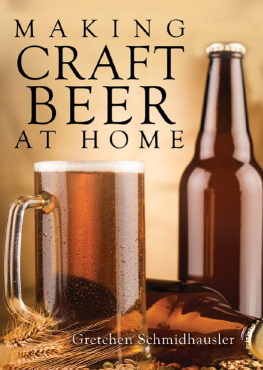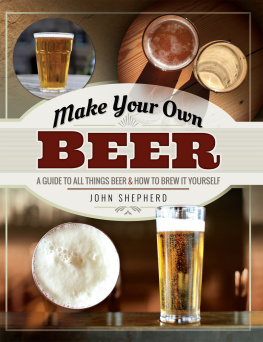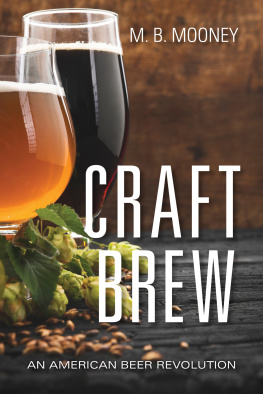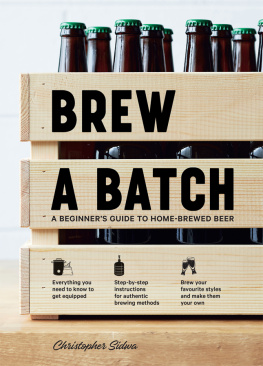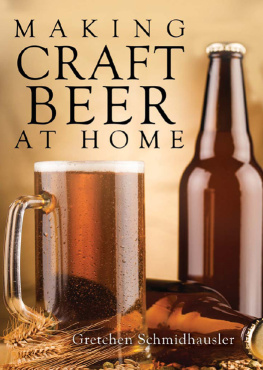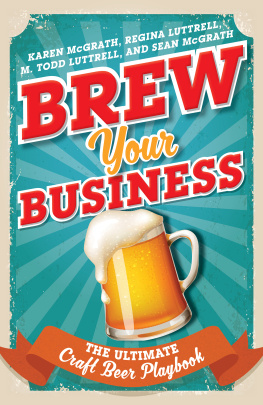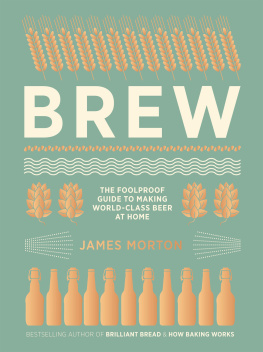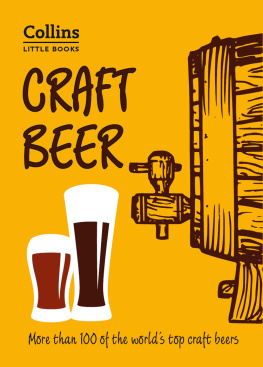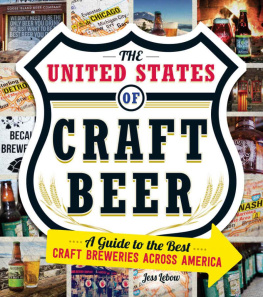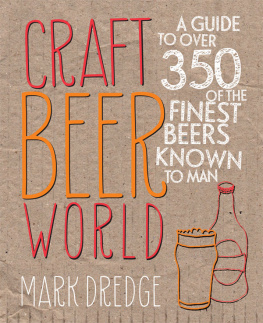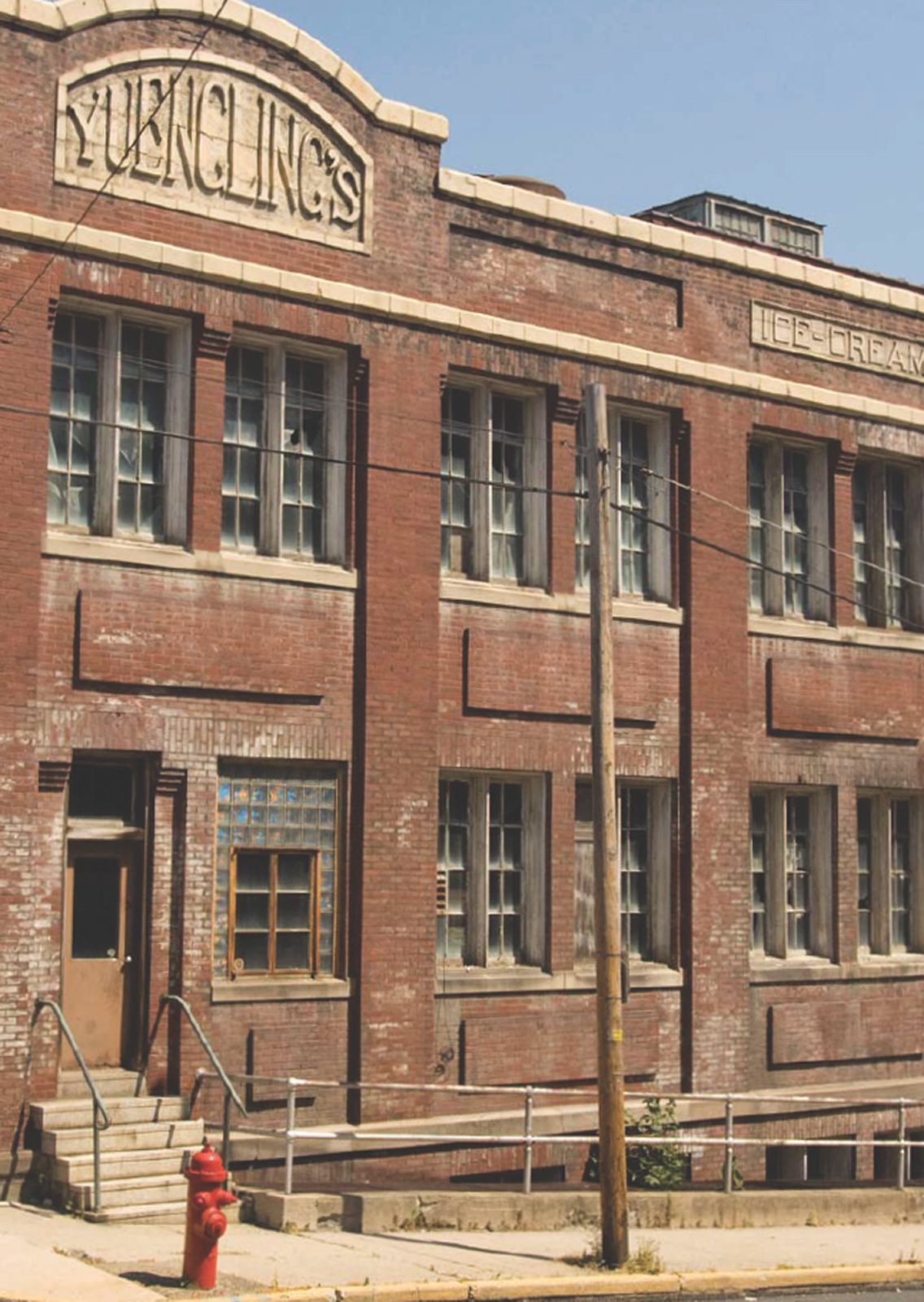MAKING CRAFT BEER AT HOME
Gretchen Schmidhausler
If youre willing to spend the money, mini-versions of commercial brewing equipment are available to home brewers. This trio of fermenters even has its own cooling system.
Barley in the field. Barley is a cereal grain that closely resembles wheat.
CONTENTS
INTRODUCTION
W ELCOME TO THE world of craft beer! I hope youll find Making Craft Beer at Home to be a good introduction to craft beer and home brewing; my goal is to provide an overview of the brewing process, while including some historical background, information on beer styles, and how and where to enjoy craft beer. Although this book will explain everything youll need to brew craft beer at home, I hope youll find it to be much more than a how-to book.
Brewing is both an art and a science, and not something you will master after reading a book or two, or even after brewing several batches of beer. If you find Ive just whetted your appetite for craft beer and brewing, see for many good books that delve more deeply into the subject. A quick Internet search, too, will put you in touch with a host of home-brew clubs, groups dedicated to the appreciation of craft beer, and brewery collectibles organizations and associations whose mission is to promote and educate consumers and enthusiasts about beer. If you want to learn more, you will soon find a network of people who share your interest.
Like any artisanal endeavor, craft beer is a product proudly and carefully crafted by men and women with as much passion for the process as for the final result. Whether you are brewing in a 3-gallon pot on your stovetop or producing a 1,000-gallon batch in a commercial brewery, the common denominator is a shared zest for crafting, creating, and enjoying this amazing fermented beverage.
I have been a professional craft brewer for almost twenty years and a beer enthusiast ever since I was a young adult. When I came of legal drinking age, my friends and I sought out beers that were different from what our fathers and older siblings were drinking. This wasnt an easy task at the time, at least at the New Jersey Shore, where I grew up. There were plenty of bars, taverns, and liquor stores, but the beers they sold for the most part were all fairly similar. Most of the beers on the market, at least the ones we had access to, fell into the same basic category: pale-colored American lagers. Nevertheless, we did admittedly drink copious amounts of these beers, which included Budweiser, Pabst, Schlitz, and Miller. When we could find them, we often turned to the imported German beers for variety, as many were available in a dark (amber) version that we loved. We would have shied away from light beers, had we even known about them we preferred the more flavorful brews. It would be years before we learned the distinction between ales and lagers, or heard the terms microbrewery or craft beer.
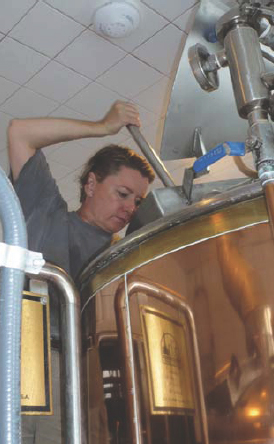
Mashing in at the brewpub. A brewday starts early.
It was like that for many years our beer universe remained small and if we asked for a dark beer, we were invariably offered a Guinness Stout! I was introduced to Canadian beers while at Mount Holyoke College in western Massachusetts, and gradually those imports and others made their way to my home state of New Jersey, and into our usual haunts and local liquor stores, although the selection was still very limited. Brewing my own beer at home was a natural progression and the next logical step for a beer lover frustrated by a lack of variety. So I began brewing myself, a novice stovetop brewer making beer from a kit. What happened next took me by surprise I fell in love. Years later, I would enroll in the American Brewers Guild in Woodland, California, and become a professional brewer, eventually opening my own small craft brewery.
A visit from the Road Brewer, Teri Fahrendorf, founder of the Pink Boots Society, an organization for women in brewing and related industries.
Over the years, I became part of a large social network thanks to my hobby and my new vocation. I now have a wide circle of good friends and colleagues who share my passion for brewing and drinking beer. I have had the opportunity to meet a multitude of beer enthusiasts, home brewers, and professional brewers. Ive been fortunate to share a judging table with some of the most respected brewers and beer experts in the world, including the late author and beer connoisseur, Michael Jackson. Ive also had the chance to tour scores of breweries and meet brewers from all over the United States and Europe.
If you enjoy this book and you find you like brewing, rest assured you neednt take your hobby to the same extremes. The wonderful thing about home brewing is that you can do it on any level and get good, satisfying results. Brewing is still hard work on any level, however, and if you dont enjoy spending time in the kitchen, you wont enjoy making beer at home. Some people find the preparation, cleanup, and bottling process quite tedious. But brewing is also a great deal of fun and tremendously rewarding, especially when you share a well-executed, well-crafted brew with friends or family.
When I was asked to write Making Craft Beer at Home, I was thrilled. I love brewing beer, I love drinking beer, and I love talking about beer with people who share my interest. Youll see I take a rather commonsense approach to beer and brewing, and throughout this book, I hope to convey my passion and enthusiasm for my favorite beverage.
Brewing is hard work! Removing the spent grain from the mash tun, or graining out, is also a messy job.
During Prohibition, D. G. Yuengling & Son survived by making near beer and diversifying into other areas, including dairy products.
THE ART AND HISTORY OF BREWING
B EER IS A simple, fermented, alcoholic drink made from water, barley (a cereal grain), hops (the bitter, pungently aromatic flower of the female hop plant), and yeast (a live, one-celled organism). Beyond those four basic components, however, beer is also a beverage that is brewed all over the world, with a complex flavor profile, and which is available in a wide range of colors, flavors, styles, and alcoholic strengths.
Beer has an ancient history traces of a primitive, fermented drink have been found in ancient Egypt and Mesopotamia, and its likely that early civilizations throughout the world made a beer-like drink. A 6,000-year-old Sumerian tablet discovered in Mesopotamia shows several people using straws to drink from a communal bowl they look like they are enjoying themselves, so maybe they are sharing a beer and a 3,900-year-old Sumerian poem honoring Ninkasi, the patron goddess of brewing, purportedly contains an ancient recipe for beer.

